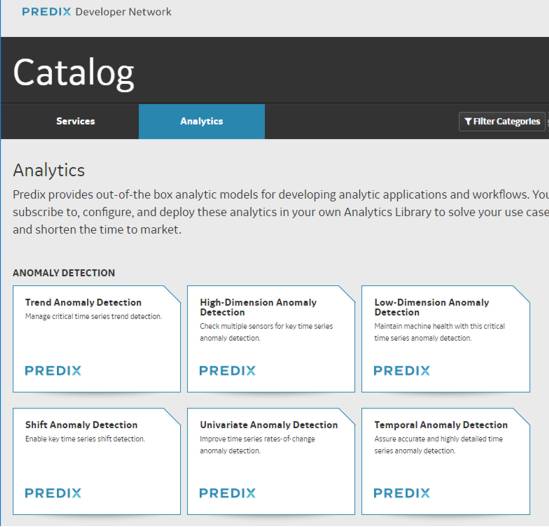| The 100+ Analytic Microservices for Predix App Development |
| Written by Beena Ammanath | |||
| Thursday, 23 February 2017 | |||
|
New analytics have been added to Predix, extending the capability of its analytic microservices for the Industrial IoT by providing the crucial insights that reduce downtime and enable users to make better decisions. Predix is GE’s application platform for the Industrial Internet. Built on Cloud Foundry, it is is optimized for secure connectivity and analytics at scale - in the Cloud and on the Edge. Analytics is the third key component of the Predix platform for the IIoT (Industrial Internet of Things) and to date The Predix Data Science team has unveiled over one-hundred unique analytic microservices on predix.io to help accelerate the development of your Industrial IoT application. The Predix Analytics Catalog is an exclusive directory of analytic microservices for the IIoT and includes analytics like Anomaly Detection and Time Series to Advanced Predictive Models and Machine Learning.
This faster time-to-market of the IIOT apps in combination with partner and customer ecosystems will have a multiplier effect on time-to-value of IIOT apps and outcomes.
If you haven’t done so already, take look at the Analytic tab on the Predix.io catalog and check out this video on how to subscribe and use an analytic:
Here is a sneak peek into the latest release of 46 new analytics on Predix.io. Anomaly Detection 3 new analytics: Image Based Diagnosis, Hotellings TSquare For Multivariate Outlier, Isolation Forest outlier detection Finding out anomalies in your operational data is an effective mechanism to perform analysis such as statistical correlation, root cause etc.. Whether you want to find an anomaly in images or abnormal patterns in dataset, these microservices provide an easy way perform analysis.
Data Exploration and Pre-processing 5 new analytics: t-SNE, Numerical Data Pre-processing, Test Exploration, Data Normalization, Ensemble Averaging For any statistical analysis or model building, data exploration and pre-processing is one of the primary steps. This is one of the most important steps and hence our wide array of microservices in this category will help you to reduce dimensions, visualize the data, generate word clouds and other methods essential to process the data prior to the actual model building step.
Optimization Methods 2 new analytics: Transport Cost Optimization, Transport Path Optimization Optimization algorithms are quite common and widely used to solve various supply chain problems across multiple dimensions such as time, cost, etc. With these analytics, one can achieve the best outcome - such as maximum profit or lowest cost- in a mathematical model whose requirements are represented by complex relationships and constraints.
Statistical Methods and Analysis 9 new analytics: System Maintainability Prediction, System Availability Prediction, Quality Dimension Ranking, Heatmap, Mean Shift Clustering Assignment, Model Performance Metrics, Residual Analysis, Apriori Algorithm, Isotonic Regression Statistical methods can be used for various business problems. With our microservices, business can determine the time to resolve any work order and system availability. The microservices can be used to determine significant features for complex problems and create heatmaps for performing impact analysis. Apart from its application in business use cases, these microservices can also be used for determining the accuracy of regression and classification algorithms.
Signal Processing 3 new analytics: Frequency Oscillation Analysis, Wavelet Transform, Fourier Transform Choose from a variety of signal processing microservices to analyze signal and sensor data. Represent signals as a function of time with Wavelet Transform; decompose a function of time into frequencies using Fourier Transform ; analyze high frequency oscillation signals using fast Fourier transform and spectrum density. These analytics are must-haves and extremely useful tools for any signal processing application.
Text Analytics and Text Mining 7 new analytics: Entity Suggester, Entity Extractor, Entity Extractor (Domain Parameterize), Information Extractor, Negation Detector, Relationship Extractor, Relationship Extractor (Domain Parameterized) Our Text Analytics and Mining category is now enriched further with domain intrinsic capabilities. The new analytics help in improved and optimized text.
Quality Control 1 new analytic: Stress-Strength Interference Our latest addition to the Quality Control category, Stress-Strength Interference helps you to analyze reliability of a product.
Network Analysis 1 new analytic: K-Clique Community Detection To ease network analysis and enable faster techniques to discover communities and clusters in highly connected and complex networks, leverage K-Clique Community Detection microservice. This analytic helps in finding possible overlapping communities with the k-Clique Percolation Method.
Predictive Models 2 new analytics: Jump Diffusion Model Fit, Simulate Jump Diffusion (Mont Carlo) The predictive models category has been enriched with analytics for fitting and simulating jump diffusions. These techniques are handy tools to act in situations triggered from short lived events. For example, sudden increase in power during extreme load fluctuation is a good opportunity to apply these analytics. Machine Learning 13 new analytics: Various classifier clustering techniques, recommender systems, Hyperparameter tuning, Db Deduplicator and explorer This has been by far our biggest update to the machine learning category. New analytics have been added to provide ready-to-use classification techniques like SVM, Logistic Regression, bagging and boosting. Key highlights include a) Recommender Systems for user/item based recommendations; and b) database techniques like Deduplicator and Explorer to study and process data.
You can start building apps for the IIoT by registering for a Predix account here; and also be sure to check out all the available analytics in the analytic tab.
More InformationPredix Related ArticlesIoT Anomaly Detection Using A Kalman Filter How to Authenticate a Device in the Industrial Internet of Things
Comments
or email your comment to: comments@i-programmer.info To be informed about new articles on I Programmer, sign up for our weekly newsletter, subscribe to the RSS feed and follow us on Twitter, Facebook or Linkedin.
|
|||
| Last Updated ( Tuesday, 28 February 2017 ) |




